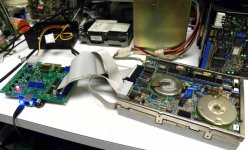Thanks for the help. I suppose "a bunch of" is relative. I've only a 8 or so not hundreds... how do you even come across hundreds!

. I have some old 386 and 486 boards. I will try and see if the will come up in a while. The drives I have I think are common.
Data recovery firm in Orange County that was going out of business and selling old inventory. Lots of NOS drives, drives to which had been opened and data recovered, drives that hadn't been touched. Some drives I tested had no errors, others had constant errors on EVERY sector. I think this guy had about 3 or 4 gaylords worth of drives. Thankfully, out of the mess, I got about 5 or 6 working drives, a PS/2 Model 50, and an older Sun shoebox that I'll be using for SCSI drives with my Sun 3/60. Oh, and some old MFM drive testers (I saved one, not sure if they chucked the other two).
If you have just 8, I'd suggest powering them up first. At least see if they sound "normal." If they make really odd noises or it sounds like the heads are crashing, then that eliminates part of your testing. I got smart and did this ultimately on several hundred drives, and it saved me considerable time.
What the success rate was?
Good question. Not that high. Maybe 1-2 drives for every 10-15? One day, I might've had a 95% success rate, the next day, maybe 5%. I wish I counted the total number of drives and then had the total number of good tested drives to get a percentage. But it wasn't that high.
I've gone through about 200 MFM drives over the past couple of months and the majority that fail either have stuck spindle motors,
head actuators (Micropolis), or they were jumpered wrong.
Or, if they are Maxtor, leaking filter caps.
Are those the components that pop and start smoking on Maxtor and Miniscribe 5.25" drives, right at the front right corner of the drive (where the drive is upside down, and the cable connector is facing away from you)? I think the Seagate ST22x series also had a bad IC of some sort that had a high failure rate, as I remember a bunch of boards reworked in the 90s to replace this IC. Nearly all of the IBM drives (non-SCSI) I'd tested were crap and didn't work. Rodime also seemed to have a bad reputation, and I couldn't get a single one of those working.
for running it as a MFM drive replacement
basically, the track images are stored in flash and sent out if the device
is running the emulation program.
for data capture, you would normally use the IDC plugs
here's a picture of my bench lashup
View attachment 35329
That's pretty cool! I've tested several drives like the one that's connected to that board, but I can't remember the brand. Was almost going to say Shugart. Looks like either a Micropolis or Miniscribe behind it, and an Imprimis to the center left.

